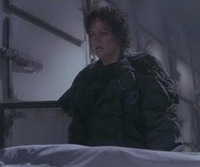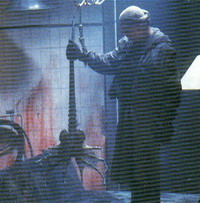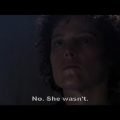Alien 3 Trivia
Posted by Darkness on December 10, 2006 (Updated: 09-Nov-2023)
Below you’ll find trivia for the film.
Pre-Production
 Multiple proposed scripts caused misleading advertising which implied that the movie would be set on Earth. William Gibson also drafted a script in which Ripley spent most of the film in a coma.
Multiple proposed scripts caused misleading advertising which implied that the movie would be set on Earth. William Gibson also drafted a script in which Ripley spent most of the film in a coma.- Early versions of the script and design featured a giant rustic monastery. Also, the alien itself would not be appearing.
- Initially, Renny Harlin was attached as director, but left to direct Die Hard 2. Then Vincent Ward came on board but only lasted a few months before being fired after several disagreements with the producers. The scriptwriter, Walter Hill, was considered to direct the film as well, but he stepped back after David Fincher became available.
- After the first draft was complete (in which the Alien attacks a monastery), construction work began on the sets. The construction shut down, leaving the crew in limbo, as the script was reworked. Although the location changed to a prison, it was decided that they would use the already half-built monastery sets.
- One early draft of the script focused almost entirely on Hicks, Bishop and Newt, played in Aliens by Michael Biehn, Lance Henriksen and Carrie Henn respectively. The story would tie up loose ends from the preceding film with Newt returning to Earth to live with her grandparents, as well as Hicks and Bishop and a new team of Colonial Marines battling a rival faction of planets who use the Alien as a bio-weapon.
- Because an early storyline of the movie involved aliens landing on Earth, an early trailer of the movie had the tagline “On Earth, everyone can hear you scream.”
- The concept by Vincent Ward based on which the movie was green-lighted involved a wooded planet and a group of monks who thought they were living in post-apocalyptic dark ages, and had a middle-ages lifestyle. The group refuses all kinds of modern technology, and when Ripley and the alien crash-land on Earth they would blame Ripley for the alien attacks. Ripley was to be impregnated by the alien “the old-fashioned way” rather than through a face-hugger, and therefore being impregnated with a human-alien hybrid. According to the storyboards, she would dream of half human-half alien hybrids. Other storyboards included horse-alien and sheep-alien hybrids. Ward left the project after the producers insisted that he change the monks to prisoners and drop the wooded planet idea.
- Vincent Ward used his payoff from this film to finance his next, Map of the Human Heart.
- Some of H.R. Giger’s design for the film involved a puma-like alien with claws. The producers also instructed him to do more sexy designs, so he created a drawing of an alien, which, in close view, had the lips of a woman. One of his ideas involved the alien kissing the victims and killing them that way (an idea that was later used in the movie Species where the main creature was also designed by Giger).
- $7 million had been spent on sets that were never used thanks to the ever-changing script before filming had even started.
- The original budget was $45 million which included Sigourney Weaver’s fee of $5.5 million. The budget soon spiralled, however, with first Renny Harlin and then Vincent Ward both leaving the project before novice feature film director David Fincher came on board. Extensive last-minute re-shoots – especially after the finale was deemed to be too similar to Terminator 2: Judgment Day – ultimately pushed the budget into the region of $65 million.
- There was some question mark over whether the character of Ripley should actually feature in this film until the then president of 20th Century Fox, Joe Roth, insisted otherwise.
- William Gibson wrote a very early script treatment for the film. As Sigourney Weaver’s involvement was in question, the main focus of this script was between Hicks and Bishop, two characters from Aliens. Many consider this to be a much superior script. The only carry-over from this original script, however, is the bar-codes on the back of the convicts’ necks.
- There are screenplay treatments by Eric Red, David Twohy, John Fasano and Rex Pickett all freely available on the Internet.
- A cross is briefly seen on the planet surface to suggest the religion that some of the inmates have turned to. The model department held a competition to see who could design the best one. Four different models were created, and then David Fincher chose the version he liked best.
Production
 The production effectively shut down for three months while the script was undergoing rewrites.
The production effectively shut down for three months while the script was undergoing rewrites.- Although the alien that hatched from the dog was a rod puppet, early filmed tests used an actual dog in an alien costume.
- First-time director David Fincher disowned the film, citing constant studio interference and actually walked out of production before editing began.
- Cinematographer Alex Thomson replaced Jordan Cronenweth after only two weeks of filming, when Jordan Cronenweth fell ill.
- The creature that the alien impregnates was originally an ox, but was eventually changed because an ox was cumbersome and was seen as somewhat incongruous when placed in the film’s environment. This sequence was later restored for the extended “Assembly Cut.”
- To create a convincing corpse of the character of Newt, the filmmakers created life size mannequins using the molds of Carrie Henn from Aliens.
- One possible idea for the film included a chest-burster coming out of Michael Biehn’s character, Hicks. A replica of the actor with his chest torn open was created, but after Biehn discovered this, he threatened to sue the producers for using his likeness without his consent, and the idea was dropped. Later, the producers paid him to use his picture at the beginning of the film for the computer sequence. Apparently, he received more money for the use of this one image than for his role in Aliens.
- The Rottweiler (from which the alien emerges) had to have part of his face shaved to indicate where the facehugger had gripped onto him.
- On the set at Pinewood Studios, a giant lead foundry took 12 weeks to construct and put the production way behind. Even with 6 day weeks and 14 hour days, the crew were unable to keep up with the schedule.
- Off-duty, Sigourney Weaver had to wear a wig as her then two-year-old daughter Charlotte didn’t like to see her mother bald.
- Because of continuing troubles with the film, Fox halted production in Pinewood Studios in England in late 1991. The crew returned to LA, and an initial screening identified the missing parts of the film. A major part yet to be shot included the killing of the alien in the lead pool. By the time of the new shots in LA, Sigourney Weaver’s hair grew back, and she had an agreement with the producers that if she had to cut her hair she would be paid a $40,000 bonus. The producers therefore hired Greg Cannom to create a bald cap with very short hair on it. The make-up process cost $16,000 and was very difficult and time-consuming because the hairline required the cap to be placed very precisely on Weaver’s head.
- At one point, David Fincher was denied permission by the film’s producers to shoot a crucial scene in the prison understructure between Ripley and the alien. Against orders, Fincher grabbed Sigourney Weaver, a camera and shot the scene anyway. This scene appears in the final cut.
- Director of Photography Alex Thomson replaced Jordan Cronenweth three days into shooting. Cronenweth was succumbing to Parkinson’s disease. He died of it in 1996.
- An advanced type of facehugger, one that impregnates Ripley with a queen embryo, was designed and built, but was cut from the Theatrical Version. It does however make a brief appearance in the extended Assembly Cut.
- The alien in this movie differs from its predecessors in that the organic pipes on its back are now missing and it now has a more pronounced set of lips.
- The crane that lifts the crashed EEV out of the water to dry land is a miniature built using the cannibalized parts from a Star Wars X-Wing fighter model kit.
Post-Production
- The film spent over a year in editing.
- When the powers-that-be decided on a new ending to be shot, Elliot Goldenthal had one night to come up with a new score.
- To create some of the wet sounds that accompany the alien, the soundmen went to Asian markets and bought animal heads and stomach linings.
Afterwards
 Hungarian title translated back to English: “Final Solution: Death.”
Hungarian title translated back to English: “Final Solution: Death.”- A series of Aliens comic books were published that were set after the events in Aliens, featuring an adult Newt returning to space with a shell-shocked Hicks to stop the retrieval of an alien specimen by Weyland-Yutani corporation. The books were re-published to accommodate Alien3, with Newt re-named Billy.
- With the release of the definitive Alien Quadrilogy on DVD in 2004, 20th Century Fox proffered David Fincher the proverbial olive branch and asked him to assemble and comment on his own Director’s Cut. Fincher declined. He was the only one of the four Alien directors to refuse to have anything to do with the project.
- In a scene towards the end of the movie where Ripley and the inmates discuss the killing of the alien, several Chinese characters can be seen on the wall. ‘chao gao wen wei xian’ which translates as ‘super high temperature dangerous’.
- The same “dipping bird” appears on the warden’s desk as was seen in the original Alien.
- The tea glass that prison superintendent Andrews is sipping on is part of the BODUM series, a tableware manufactured in Denmark.
- Dr. Clemens’s line about Fury-161 being one of “Weyland-Yutani’s backwater prison planets” was the first time the name Weyland-Yutani was spoken out loud. It had appeared on computer screens and props in the previous two films, but characters always referred to it as “the Company” when speaking.
- In wide shots, most of the refinery is actually made of cardboard.
Cast
- Gabriel Byrne was offered the role of Clemens.
- Sigourney Weaver said she would only re-shave her head for re-shoots if she got a bonus.
- Sigourney Weaver had a clause in her contract specifying that Walter Hill and David Giler would write the final shooting script. Weaver has said that she considers Ripley a very difficult character to write, and, with the exception of James Cameron, only Giler and Hill have really ever written the character correctly.
- Richard E. Grant turned down the role of Clemens. Director David Fincher offered him the role as he was a huge fan of Withnail & I (1987) and wanted to reunite Grant with co-stars Paul McGann and Ralph Brown.









